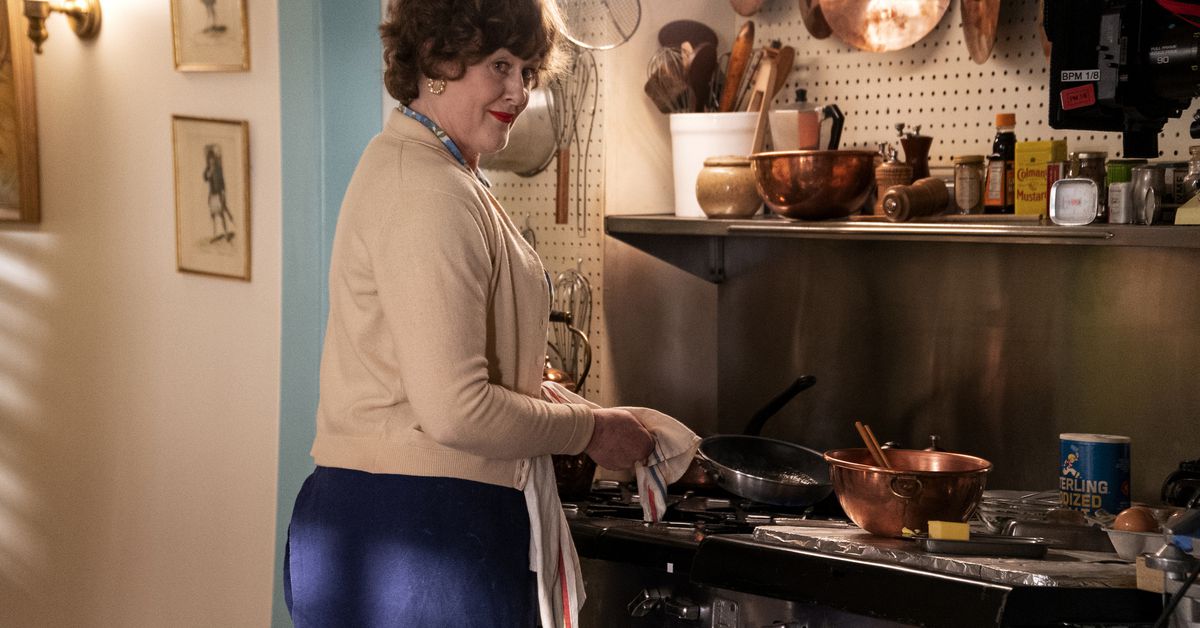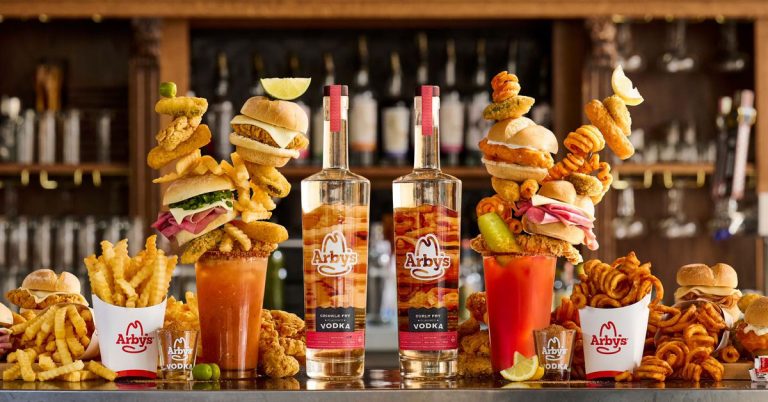Review: Haven’t We Told Julia Child’s Story Enough?
In the fourth episode of Julia, a new scripted series about Julia Child from HBO Max, the iconic chef has returned from a reunion at Smith College. She’s been fawned over all day, told that she is the only one in her class who sought the life of adventure and passion they all dreamed about in school. She listens politely as women project their fantasies onto her, assuming things she has no time to confirm or deny. One woman even credits Child with awakening her homosexuality, saying it’s because of a night of skinny dipping and gin that she now lives with a woman. Child returns home to her husband Paul in a daze. “It’s the strangest thing,” she says. “People thinking I belong to them now.”
When does a person become a myth? Julia Child may be one of America’s most recent, her celebrity only growing since her death in 2004. Regardless of who she was, her story — or versions of it — has been told so often that we know most of the beats. There’s her warbling voice and tall stature. There’s the doting and effeminate Paul with whom, by all accounts, she shared a wild chemistry. There’s the butter and the sole meuniere in France that changed her life, her time at le Cordon Bleu, and the nine-year process of writing Mastering the Art of French Cooking, which revolutionized home kitchens across America. She had her cooking show, and voila, she became an icon, worthy of multiple biopics and representations in pop culture.
Julia, which premiers on March 31 and stars Sarah Lancashire as Julia Child and David Hyde Pierce as Paul, is the latest attempt to narrativize Child’s life, and you wouldn’t be wrong to ask what else is there to say? By now, we’ve had both the book and the movie Julie & Julia, multiple documentaries, numerous biographies, Dan Aykyrod’s memorable SNL impression, plus Child’s own contributions to the worlds of TV, writing, and eating. There’s an upcoming food competition series on which contestants will attempt to recreate her recipes. If you want to know what happened in Child’s life, the information is there.
What HBO Max’s Julia attempts to do is grasp the humanity behind the woman that so many of us now feel ownership over. Sometimes it succeeds, letting viewers soak in how remarkable her achievements were, but also the toll they must have taken on her emotionally and mentally. But for all the show’s best effort, I still wonder if it might be time to leave Julia Child alone.
The series positions itself as an exploration of the emergence of public television, and the changing nature of fame and feminism in the 1960s through the lens of Child’s The French Chef. Indeed, it’s at its best when it concerns itself with the muck of creating a cooking show. In Julia’s telling, women — like Child’s friend Avis DeVoto (Bebe Neuwirth), her editor Judith Jones (Fiona Glascott), and WGBH producer Alice Naman (played by Brittany Bradford); Naman is “an amalgamation of individuals working at WGBH and in public television at that time,” including producer Ruth Lockwood, according to HBO PR — are the ones who understand Child’s talent and charisma, and who must convince or circumvent the men. Even Paul, who thinks television is a tacky fad, must be convinced of the concept over dinner, with Jones eventually manipulating him into thinking the show is his plan. Julia depicts The French Chef’s creation as Child’s idea, with her explicitly pitching it to the network and funding the pilot on her own, rather than the prevailing story that she so captivated viewers as a guest on a different show that WGBH asked her to come back and do a show of her own.
I’ve watched the first five episodes of Julia, and the parts about The French Chef are captivating. In one episode, Child’s inner circle stands in her kitchen, mapping out her television choreography and figuring out how to make coq au vin in half an hour. One person presciently suggests having the dish pre-cooked, so Child can reveal the finished version just after she puts the prepped one in the oven. Another person says she should be seen taking a bite and enjoying her own food. After cameramen are stumped as to how to shoot what’s happening in a bowl, a producer sets up a mirror above Child’s counter to allow for better angles.
But the show isn’t called The Making of ‘The French Chef.’ It’s called Julia, and as such, Julia and husband Paul are at the narrative center. Much time is devoted to Paul’s insecurities and resentment over Juila’s growing fame, and Julia’s growing taste for public life and its perks. Paul mounts an art show and grumbles that people are only there because he’s Julia Child’s husband. Julia spends a night at a drag show with James Beard, feeling ever less guilty for leaving Paul behind. It’s compelling, albeit a little unsettling in the way it often is watching a fictionalization of a real relationship in which neither person is alive to confirm or deny what really happened.
Furthermore, centering Julia and Paul makes the prolonged focus on the rest of the characters seem sometimes pointless. No matter how well acted, there’s only so much one can care about Judith Jones juggling clients Child and John Updike, or Naman, a Black woman fighting against racist and sexist assumptions so she can get credit for her work, without wondering when we’re getting back to Child’s well-trodden narrative. In trying to be both about the creation of The French Chef and about Child herself, Julia overreaches and often misses both marks.
But that might not matter. Lancashire pulls off a perfectly adorable Child, and scenes of her laughing while flambeing crepes or delivering lightly raunchy jokes to a delighted audience may be all anyone is looking to watch In These Dark Times. Child’s story is a comfort at this point because we know her show becomes wildly successful, she writes more and more books, and by all accounts lives happily ever after. Watching Julia’s rise — the fan mail, the lines of people waiting to get books signed, the spread of the show across the country — is one thing, at least, that audiences can rely on.
In his book Tastemakers, Mayukh Sen writes that Julia Child “possessed a unique qualification that allowed her to be a great teacher of French cooking for Americans: She carried no threat of the outsider.” Yes, she was loud and funny and immensely talented, and yes, she was a woman who achieved fame and respect in a sexist world. At the same time, she’s a safe choice for an audience in 2022 — a white American woman from a wealthy family, with ins at American publishing companies and television stations. It’s true that she was and is a slightly unconventional choice for a celebrity, but not an earth-shaking (or society-breaking) one.
In one episode, James Beard (played by Christian Clemenson) elaborates on this to Child, explaining one reason why her cooking show is a hit and his has fizzled out. “America can’t love a fat old fairy like me,” he sighs. Fifty years later, he continues to be mostly right. With some notable exceptions, the people who dominate food fame remain white, straight-presenting, and all manner of other identities that let them read as “non-threatening” to white audiences.
After half a century of stories about Julia Child, what would it mean to tell someone else’s? What would it mean to not have comfort or inoffensiveness be the determiners of what art gets created, or whose stories are revisited? Why not make a show about “fat old fairy” James Beard, or successful TV chef Joyce Chen, or J.Ranji Smile? Representation is a slippery goal, too often considered an endpoint of anti-discrimination rather than a beginning. But tell one story enough and it starts to sound like the only one.
Julia’s existence proves Julia right — the public does think she belongs to them. She endures because she means something to so many people, whether it’s because they learned to cook from her show or love her books or have their own impression of her in their back pocket. You can make the case that any number of chefs from the past are equally talented and worthy and would make for a compelling narrative, but you can’t reverse engineer nostalgia. Instead, you must make it so that the next time someone wants to look back, they see more than just one face.






